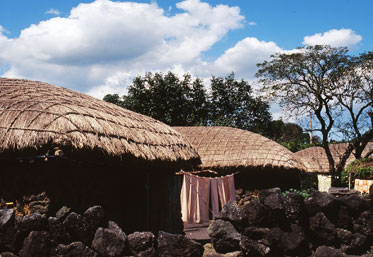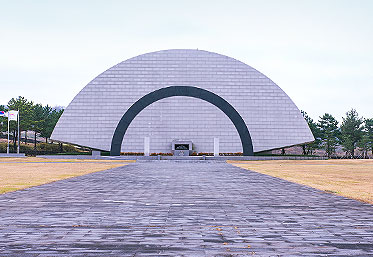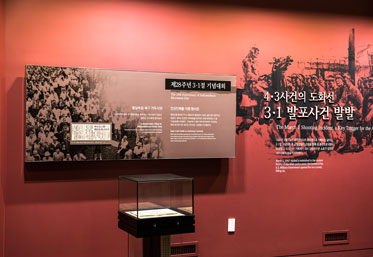Tamna, Jeju’s former name, means ‘Island Country’. The process of establishment of Tamna on Jejudo Island can be seen in the Tamna Birth Myth, which is known as the ‘Samseong Myth’. If you would like to see archaeological traces, then you can visit the ‘Archaeological Site in Samyang-dong, Jeju’. Registered as Historic Site 416, the Archaeological Site in Samyang-dong, Jeju is a large-scale village site that was first formed around 300 BC, during the original Three Kingdoms of Korea. It portrays the society that existed in the time of Tamna Creation Myth (200 BC to 200 AD). Tamna had separate trade relations with Baekje, Goguryeo, and Silla during the period of Three Kingdoms. Even after Baekje’s demise due to the Silla and Tang allied force, Tamna established foreign relations with Japan and China’s Tang Dynasty, continuing its legacy as an independent marine empire.
History of Jeju
Let’s travel through Jeju’s history, from Era of Three Kingdoms to modern history,
going through Goryeo, Joseon, and the Japanese Colonial Era as well.
Thousand Years of History, Tamna
‘Tamna’ Changes into ‘Jeju’
It was on the 10th year of King Sukjong (1105) of Goryeo that the ancient sea nation Tamna lost its status as an independent nation. During the reign of King Gojong (1213-1259) of Goryeo, Tamna was renamed Jeju, which meant ‘a large village across the ocean’. The main traces of Jeju during the Goryeo Dynasty are related to the Sambyeolcho. Jejudo Island is the last ferocious battlefield of the Sambyeolcho, the main force for Hangmong (Anti-Mongolian) resistance during the Goryeo Dynasty. The remnants of Hwanhaejangseong Fortress, which was built on seaside by both Goryeo Government Military and Sambyeolcho Military, and the Hangmong (Anti-Mongolian) historic site where the Sambyeolcho troops were stationed can be found in the island. The Sambyeolcho army fought against the Yeomongyeonhapgun by building various fortification infrastructure and even Hangpaduriseong Fortres, which contained both the palace and government office, in Aewol. However, they eventually fell during the 14th year of King Wonjong’s reign of the Goryeo Dynasty (1273). After that, until General Choe Yeong suppressed the Mokhogun at the last days of Goryeo Dynasty, Jeju remained under the control of Mongols. Saebyeol Oreum Volcanic Cone, Oedolgae Rock, Maksuk, and Beomseom Island are all historic ruins of General Choe
Yeong and Mokhogun’s fierce battle during the Goryeo Dynasty.
Yeong and Mokhogun’s fierce battle during the Goryeo Dynasty.
Smeared with Lamentation, ‘the First Exile District’
Since the Goryeo Dynasty, Jeju was used as an island to send exiles. The Yuan Dynasty, which subjugated Goryeo, exiled not only thieves and criminals but also members of royalty, administrators, and monks to Jejudo Island after the conquest of the Sambyeolcho by using Jeju as their directly controlled site. It was during the Joseon Dynasty that Jeju became used as an official site of exile. Over 200 people who exiled to the island during the 500 years of the Joseon Dynasty, and this included an array of individuals from all positions of society, such as members of royalty and their maternal relatives, nobles, and academics, as well as thieves and people who were caught trespassing on the borders. The influence exerted by the various eminent people that were exiled to Jeju during the 500 years of Joseon Dynasty is not small. One of the main influencers included Chusa Kim Jeong-hui. The infamous Sehando (Winter Scene) and Chusa’s calligraphic style were completed during his exile at Jeju. Located in Anseong-ri, Daejeong-eup, Kim Jeong-hui’s House in Exile has been well restored.
3 Eups (Town), 9 Jins (Military Forts), 25 Bongsu (Beacon Fire Station), 38 Yeondae
For 500 years during the Joseon Dynasty, Jeju was governed in a three-eup (town) structure differentiated by Jejumok, Jeonguihyeon, and Daejeonghyeon. Each town had its own town wall and government facilities and buildings were built within the town wall. A Hyanggyo (Confucian School), a national educational facility, was also established in each town. As a result of Japanese raiders, there was a sturdy fortification structure. Some of the ruins that show Joseon Dynasty’s fortification structure include Hwanhaejangseong Fortress, which encompasses all coastal aspects of Jeju, Yeondae, which was set up in the seaside, and Jinseong, which was implemented as a Banghoso (protective wall). Banghoso had 9 Jins (Military Forts) including Hwabukjin, Jocheonjin, Byeolbangjin, Aewoljin, Myeongwoljin, Chagwijin, Moseuljin, Seogwijin, and Susanjin, and a fortress was built in every Jin (Military Forts). Mountains were connected by communication facilities known as Bongsu (Beacond Fire Station), while the shoreline was connected by Yeondae. There were 25 Bongsu (Beacon Fire Station) and 38 Yeondae. Remains of these defensive facilities can be found all over Jeju, as there are quite a bit of them left.
A Painful Past, but a scar that must be confronted: Japanese Colonial Era
Jeju was not exempted from the brutal Japanese colonial rule. After moving into war footing in the 1930s, Japanese forces began to reinforce its military facilities throughout the entirety of Jejudo Island after claiming it as a major military base. Many Jeju residents were mobilized for the construction of military facilities, which caused a lot of suffering. Many Jeju residents were mobilized or dragged to the battlefield under the title of conscription or comfort women under Japanese rule in wartime. Even during such difficult circumstances, Jeju residents’ anti-Japanese movement was impressive. The Beopjeongsa Anti-Japanese Movement that occurred one year before the 3.1 Movement, the anti-Japan movement that lead by women divers, the Samil Independence Movement that took place in Japan, the mass civil movement for anarchism, and other anti-Japan movements that would have been difficult to carry out in other regions were all carried out by Jeju residents. It is recommended that you take the time to visit Jeju Hangil Memorial Hall, the only region in Korea to integrate its anti-Japan movements, as well as the Japanese imperialism
historical sites that remain scattered but intact throughout Jeju.
historical sites that remain scattered but intact throughout Jeju.
To Experience Peace, You Must Know About 4 ∙ 3
In 1948, Jeju experienced the 4 ∙ 3, one of the biggest tragedies of Korean modern history. Tens of thousands of people were sacrificed and more than 130 villages were completely wiped out. 4 ∙ 3 is the gale that ravaged the entire Jejudo Island for 7 years. It is hard to find a place that is not a historic site of 4 ∙ 3 in Jejudo Island. These days, Jejudo Island is known as the Island of Tourism and the Global Peace Island. In order for you to experience ’true peace’ and understand the peace that Jeju retains, you must understand the difficult and traumatic times that Jeju underwent to get to where it is now. If you do not know about its painful history, then your tour can only be half-sided. It is recommended that you visit the Jeju 4 ∙ 3 Peace Park, which is now being used as an educational platform for peace and human rights as well as a reminder to reflect upon the events of Jeju’s 4 ∙ 3.


